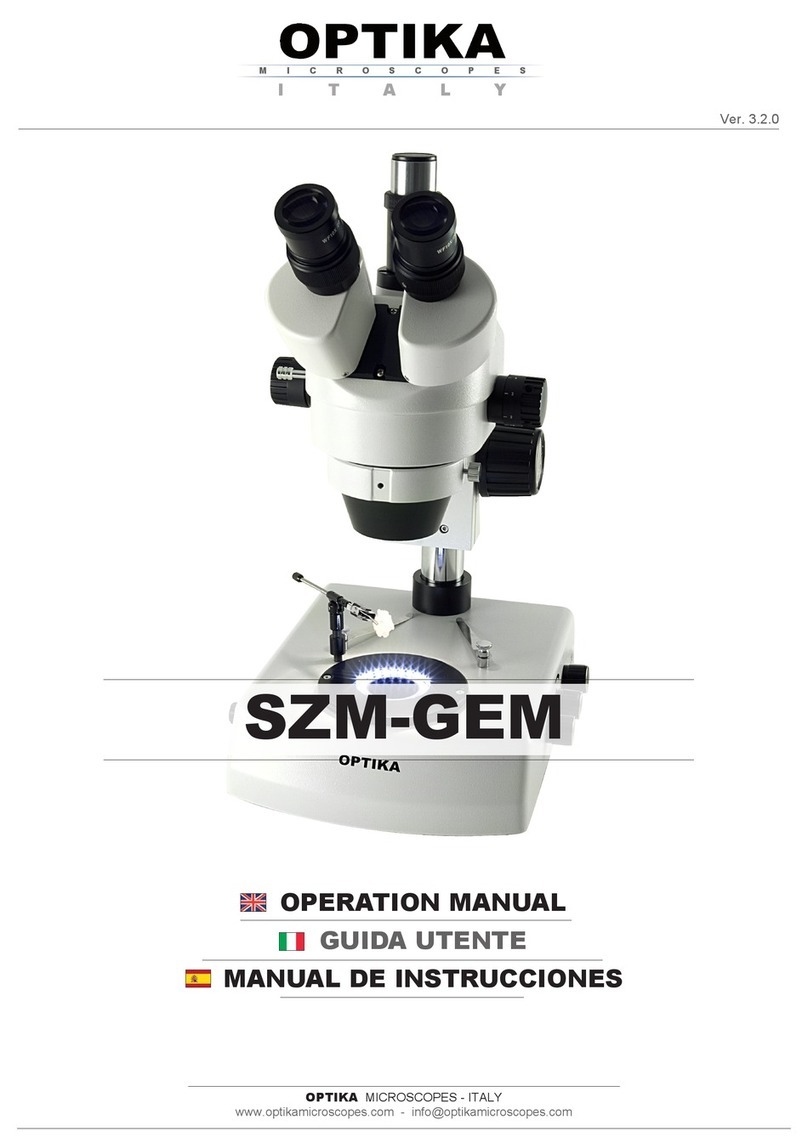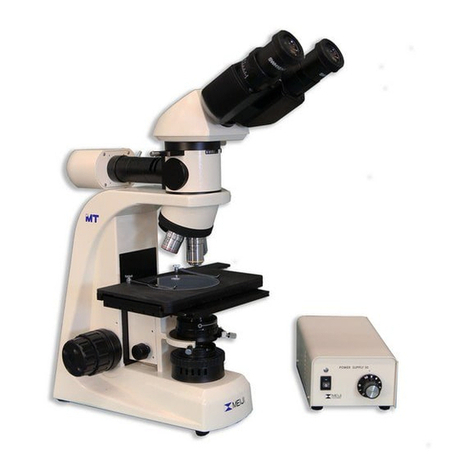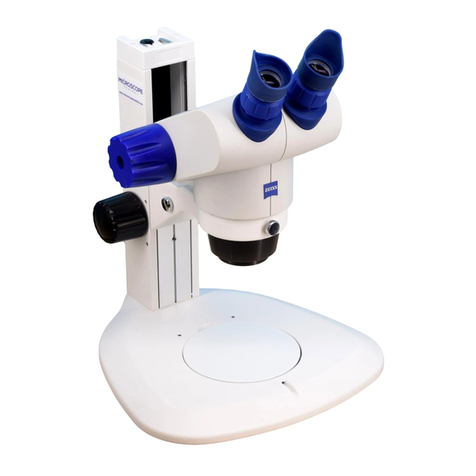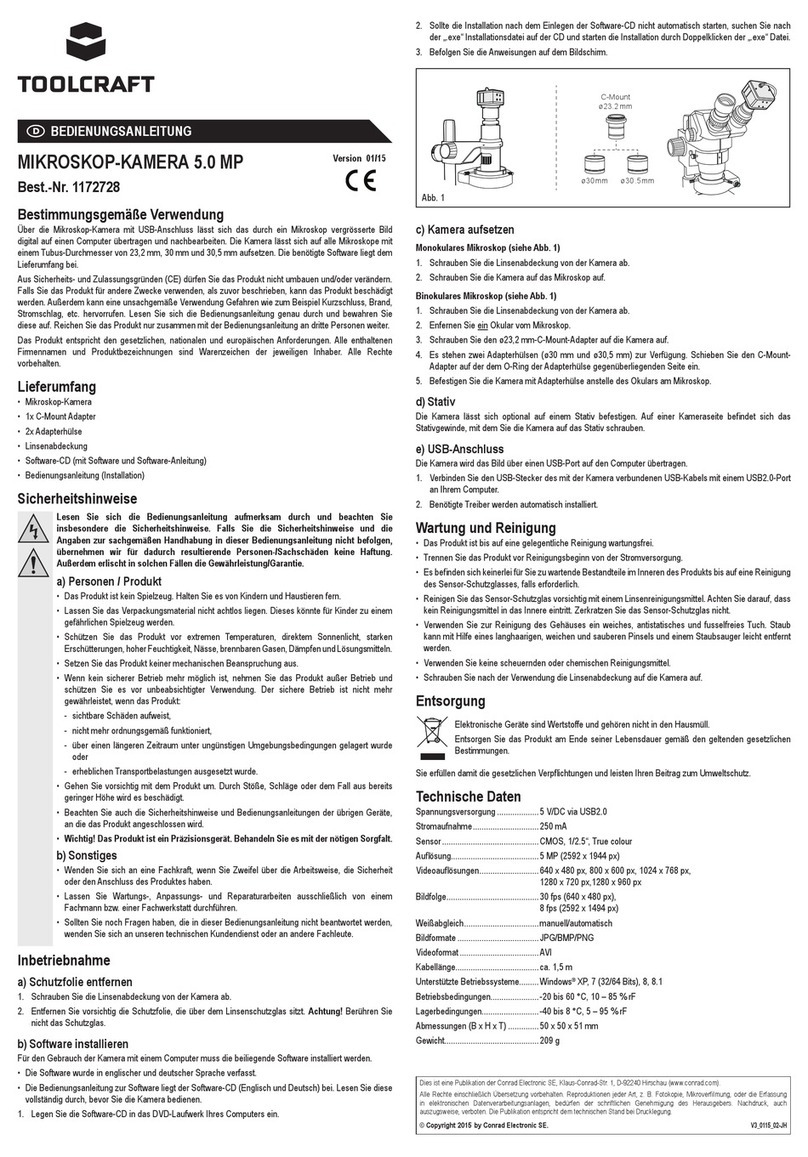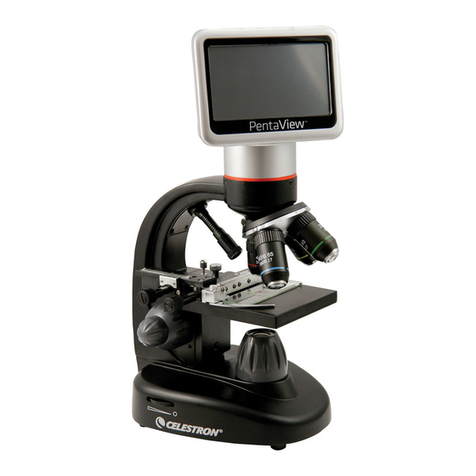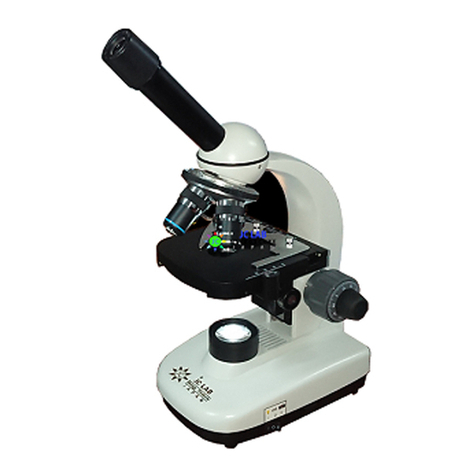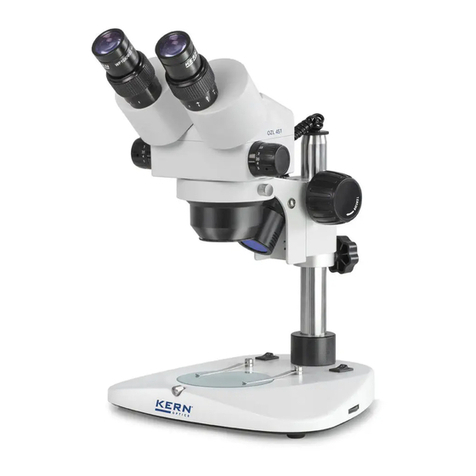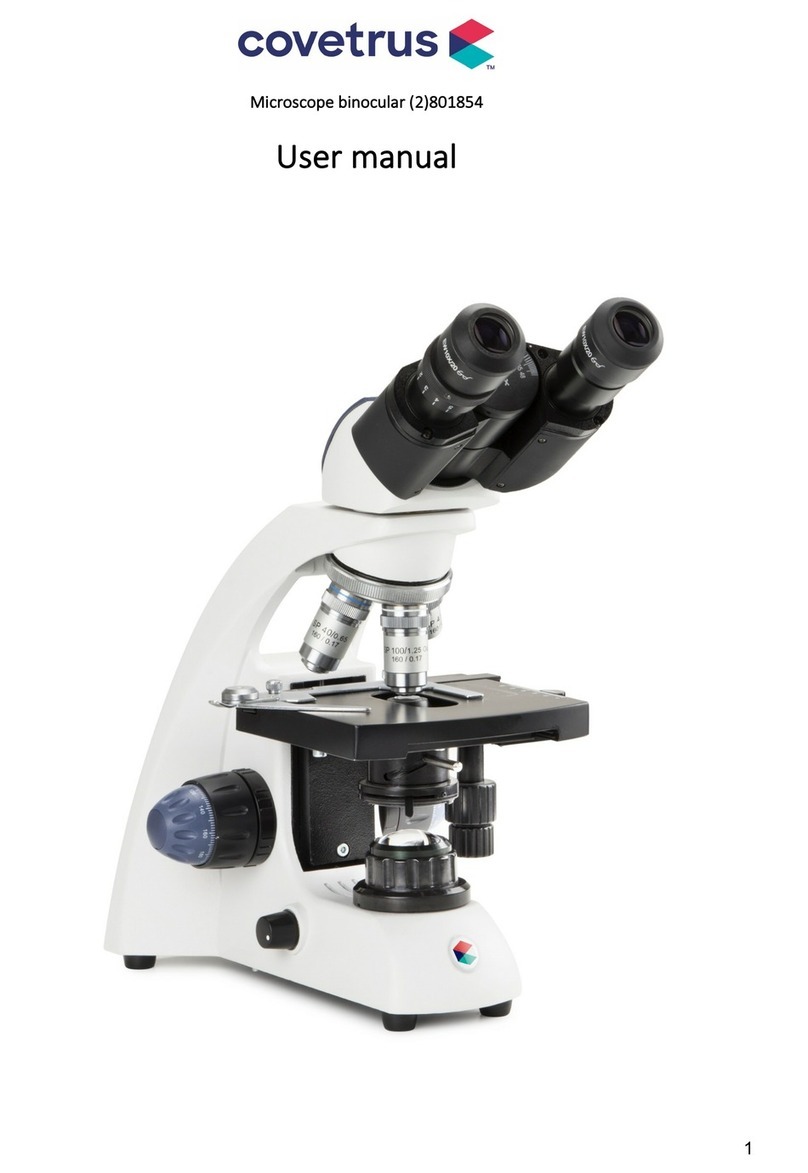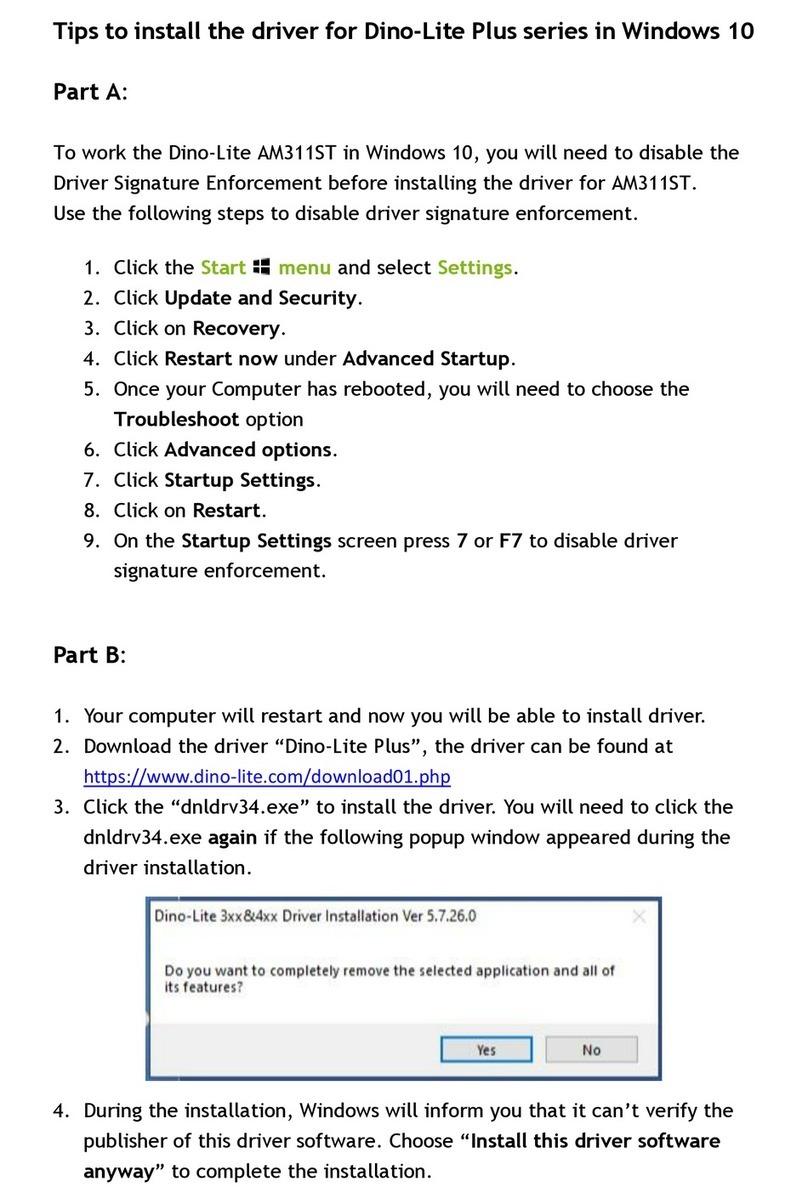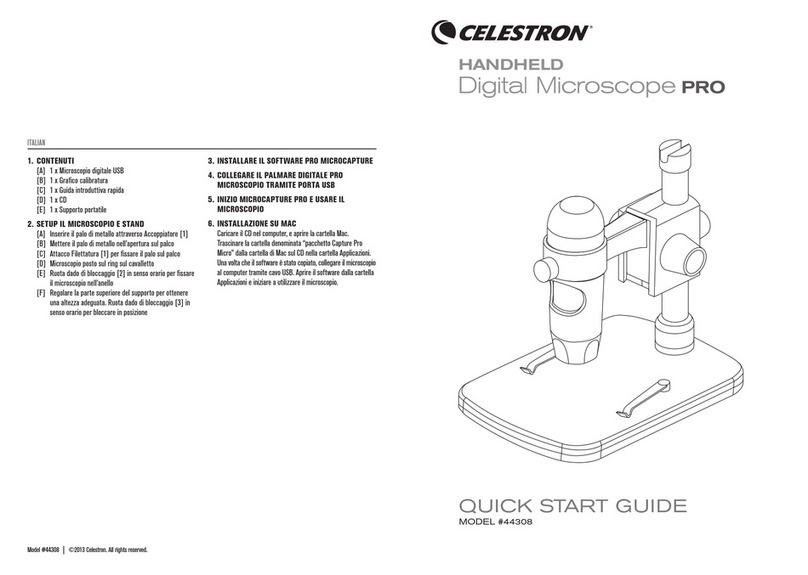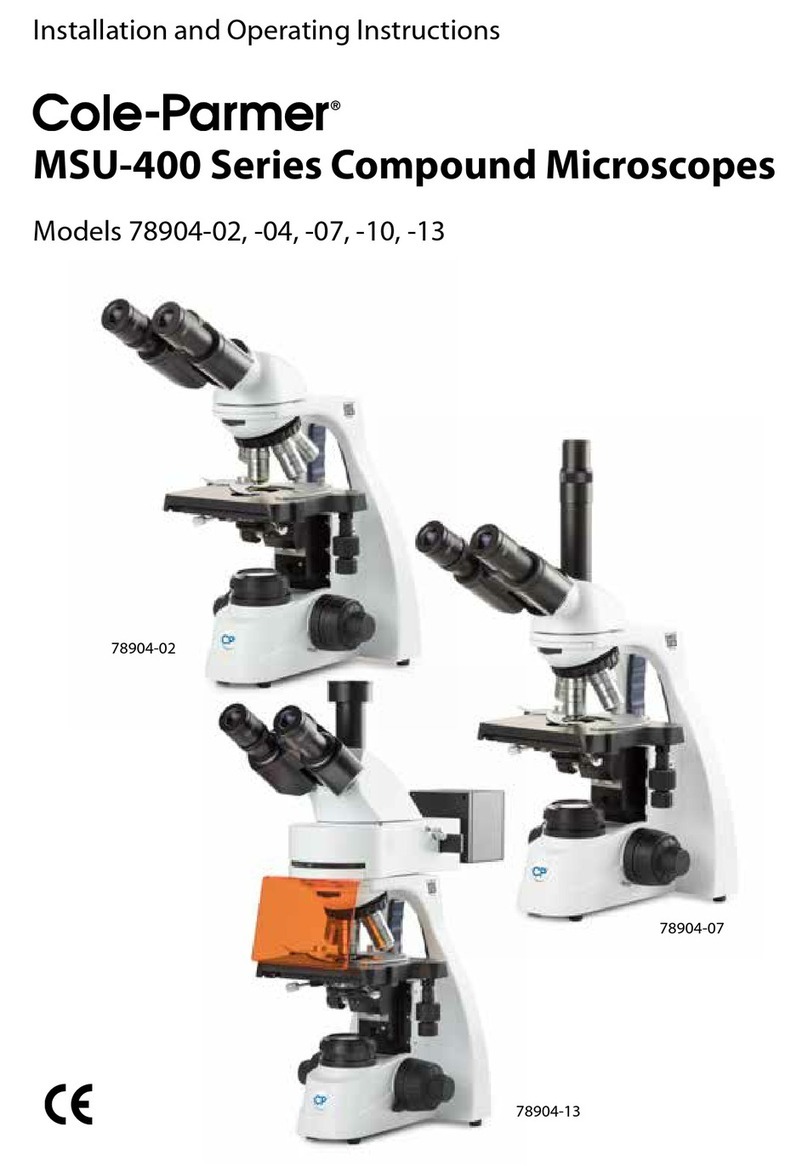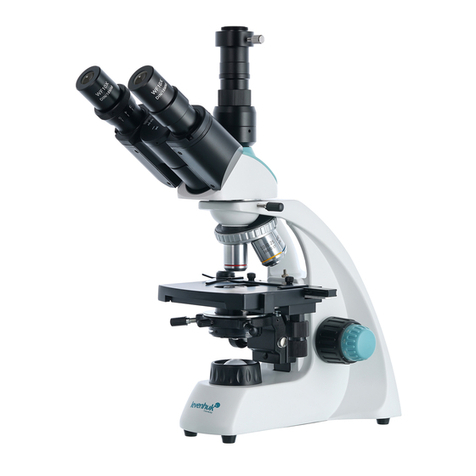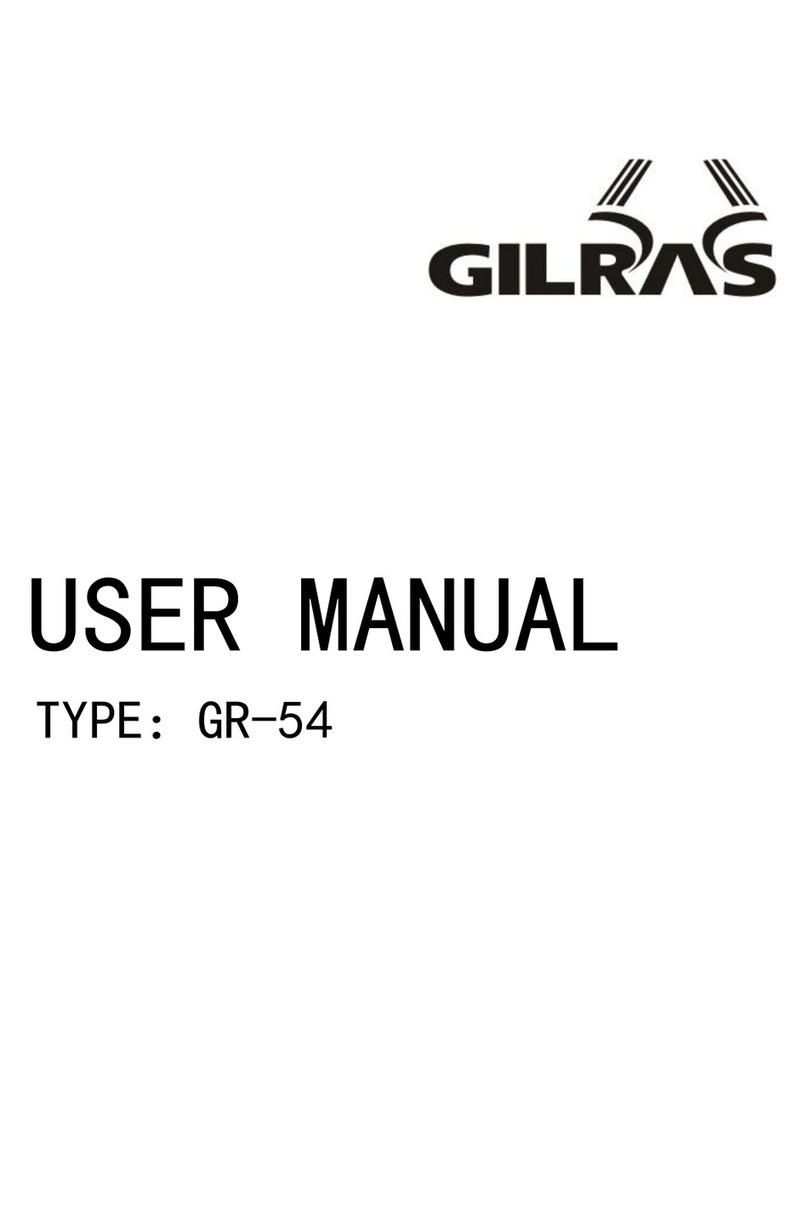OPTIKA MICROSCOPES B-500POL-I User manual

OPTIKA MICROSCOPES - ITALY
Ver. 1.0.0
B-500POL-I
OPERATION MANUAL
GUIDA UTENTE
MANUAL DE INSTRUCCIONES

Page 2
INDEX
1.0 DESCRIPTION page 4
2.0 INTRODUCTION page 6
3.0 UNPACKING AND ASSEMBLY page 6
4.0 USING THE MICROSCOPE page 9
5.0 MAINTENANCE page 14
6.0 ELECTRICAL SPECIFICATION page 14
7.0 RECOVERY AND RECYCLING page 15

Page 3
This microscope is a scientic precision instrument designed to last for many years with a minimum of main-
tenance. It is built to high optical and mechanical standards and to withstand daily use.
Optika reminds you that this manual contains important information on safety and maintenance, and that it
must therefore be made accessible to the instrument users.
Optika declines any responsibility deriving from instrument uses that do not comply with this ma-nual.
Safety guidelines
This manual contains important information and warnings regarding safety about installation, use and
maintenance of the microscope. Please read this manual carefully before using the equipment. To
ensure safe use, the user must read and follow all instructions in this manual. OPTIKA products are
designed for safe use in normal operating conditions. The equipment and accessories described in
the manual are manufactured and tested according to industry standards for safety instrumentation
laboratory. Misuse can cause personal injury or damage to the instrument. Keep this manual at hand
close to the instrument, for an easy consultation.
Electrical safety
Before connecting the power cord to wall outlet, ensure that your mains voltage for your region corre-
sponds to the voltage supply of the instrument, and that the illuminator’s switch is in position OFF. The
user must observe the safety regulations in force in his region. The instrument is equipped with CE
safety marking, in any case the user has full responsibility concerning the safe use of that instrument.
Warning/Caution symbols used in this manual
The user should be aware of safety aspects when using the instrument. Warning or hazard symbols
are shown below. These symbols are used in this manual.
The instructions on this symbol to avoid possible severe personal injuries.
Warning of use; the incorrect operation on the instrument can cause damages
to the person or instrument.
Possibility of electric shock.
Attention: high temperature surfaces. Avoid direct contact.
Technical notes or usage tips.
SAFETY GUIDELINES

Page 4
1.0 DESCRIPTION
PHOTO PORT
LEVER
EYEPIECE
TINT PLATE
HOLDER
FIELD
DIAPHRAGM
STAGE LOCK
KNOB
OBSERVATION
HEAD
NOSEPIECE
APERTURE
DIAPHRAGM
TENSION
ADJUSTMENT
KNOB
POLARIZER
ANALYZER
POLARIZER
REFLECTED/
TRANSMITTED
LIGHT SELECTION
FIELD
DIAPHRAGM
APERTURE
DIAPHRAGM

Page 5
1.0 DESCRIPTION
STAGE
DIOPTRIC ADJUSTMENT
RING
BERTRAND LENS
ATTACHMENT
CONDENSER
CENTERING
KNOBS
BRIGHTNESS
ADJUSTMENT
KNOB
CONDENSER
ADJUSTMENT
KNOB
FOCUS-STOP
KNOB
DIAPHRAGMS CENTERING
SCREWS
FINE FOCUSING
KNOB
COARSE
FOCUSING KNOB

Page 6
This microscope is a scientic precision instrument designed to last for many years with a minimum
of maintenance. It is built to high optical and mechanical standards and to withstand daily laboratory
use.
Optika reminds you that this manual contains important information on safety and maintenance, and
that it must therefore be made accessible to the instrument users.
Optika declines any responsibility deriving from instrument use that does not comply with this
manual.
3.0 UNPACKING AND ASSEMBLY
3.1 The microscope is housed in a moulded Styrofoam container. Remove the tape from the
edge of the container and lift the top half of the container. Take some care to avoid that the
optical items (objectives and eyepieces) fall out and get damaged. Using both hands (one
around the arm and one around the base), lift the microscope from the container and put it on
a stable desk.
3.2 The objectives are located in individual protective vials. Remove the objectives from the vials
and insert them into the microscope nosepiece in the order from the lowest magnication to
the highest, in a clockwise direction from the rear.
3.3 Insert the reected light attachment onto the top of the microscope stand and lock its screw.
Connect the mains plug into the socket at the base
The power cord should be used only on network sockets equipped with adequate grounding.
Contact a technician to check the state of your electrical system. If there is no need to install
additional accessories, the instrument is now ready for use. Once positioned and installed
with the necessary components, the microscope is ready to be used. Your microscope is a
laboratory instrument designed to last. Handle it always carefully and avoid abrupt vibrations
or shocks. Always disconnect the power cable from the microscope when not in use for long
time, while you clean it or when you perform any maintenance.
AVOID DISASSEMBLING THE INSTRUMENT
Do not disassemble the instrument. This entails the cancellation of the warranty and may
cause
malfunction.
2.0 INTRODUCTION

Page 7
FIXING SCREW
3.4 Connect the reected light cable to the back side of the microscope.
3.5 Put the Bertrand lens attachment on the reected light illuminator and rmly x it using the
provided allen wrench
3.6 Insert the observation head onto the top of the Bertrand lens attachment and lock its screw.
Insert your adaptor in the hole on the top of the observation head and xate it with the
screw on the side:
3.7 Insert the eyepieces into the eye tubes.
3.0 UNPACKING AND ASSEMBLY

Page 8
3.8 Insert the condenser into its holder and lock its screw.
3.0 UNPACKING AND ASSEMBLY

Page 9
COMMON SETTINGS FOR TRANSMITTED AND INCIDENT LIGHT
4.1 Adjust the observation head
Loosen the lock-screw, turn the observation head to a comfortable position for observation,
and then lock the lock-screw.
4.2 Place the specimen on the stage
Fix the specimen slide on the mechanical stage using the slide-clamp. Ensure that the
specimen is centered over the stage opening.
4.3 Lamp settings
In order to activate the transmitted light illuminator, insert the plug of the mains cable into
the socket and turn on the switch on the back of the main body. Turn the brightness adjust-
ment knob to a brightness suitable for observation.
4.4 Preliminary settings
Before trying to focus the sample, ensure that:
The eld diaphragm is fully open.
The aperture diaphragm is fully open.
No lter is inserted under the observation head.
The analyzer lter is in OUT position (lever fully pulled out).
Photo port closed (lever fully in).
Bertrand lens in OUT position (you read “0” on the Bertrand lens disc under the observation
head). Swing out lens of the condenser in OUT position (if you use the 4X objective).
4.5 Adjust interpupillary distance
Hold the right and left parts of the observation head using both hands and adjust the interpu-
pillary distance by turning the two parts until one circle of light can be seen.
4.6 Focus and diopter adjustment
Loosen the focus-stop knob, rotate the coarse focusing knob to bring the slide into focus with
a 4X or 10X objective. Adjust the ne focusing knob to get the image sharp and clear while
observing with your right eye, then turn the left diopter ring to a sharp and clear image also
with the other eye. Turn the tension-adjust-knob to get a suitable tension for the focus system.
4.7 Align the system
Transmitted light: Insert the swing out lens of the condenser and fully close the eld dia-
phragm. Rotate the condenser adjustment knob until you see a sharp image of the closed
eld diaphragm (a bright spot of light). Act on the condenser centering screws until you move
the bright spot in the center of the image eld. Then re-open the eld diaphragm.
Incident light: Completely close the eld diaphragm and act on its centering screws in order
to put the bright circle in the eld center. Then open the eld diaphragm and close the aper-
ture diaphragm: act on its centering screws in order to have a centered distribution of light in
the eld (no signicant vignetting should be noticed along the eld edge).
4.0 USING THE MICROSCOPE

Page 10
4.8 Center the stage
With the Bertrand lens out, focus on your slide. Center the optical axis of the objective you
are using with the rotation axis of the stage using the two centring screws above each ob-
jective.
A fairly easy method of centring is the following: look at your sample while continuously
rotating the stage clockwise and then counter-clockwise by a little angle (e.g. 30° or 45°).
During these oscillations you should spot a point on the sample that doesn’t rotate on a
circumference but only revolving about itself. With the two objective’s centering screws,
bring this point in the center of the eld of view. In this way the mechanical center of rotation
of the stage coincides with the system’s optical axis. The stage can be locked in its position
using the stage lock knob.
4.9 Set the numerical aperture
Adjust the aperture of the iris diaphragm under the condenser to set the numerical aperture
of the illuminator, thus controlling image contrast and resolution.
4.10 Bertrand lens
In order to have a conoscopic view of your sample, you can insert a Bertrand lens in the
light path by rotating the disc under the observation head.
The Bertrand lens can be ne aligned along Z axis by rotating the knurled focusing knob.
The lens can also be centered in X-Y axis by means of two screws located at the back of
the lens.
“B”: BERTRAND LENS IN
“0”: BERTRAND LENS OUT
BERTRAND LENS Z- AXIS
FOCUSING KNOB
INSERT HERE THE PROVIDED
SCREWDRIVERS
TO CENTER THE OBJECTIVE
4.0 USING THE MICROSCOPE

Page 11
TRANSMITTED LIGHT SETTINGS
4.11 Polarizerandanalyzerlters
Insert or remove the lower polarizer as required. It can also be rotated at any angle:
The analyzer lter can be inserted by means of the slider a the right side of the Bertrand lens
attachment. The analyzer has a rotatable knob with a vernier scale engraved. For the “crossed
Nicol” position put the scale in the “0” position.
4.0 USING THE MICROSCOPE

Page 12
REFLECTED LIGHT SETTINGS
4.12 Polarizerandanalyzerlters
Insert or remove the reected light polarizer as required.
The analyzer lter can be inserted by means of the slider a the right side of the Bertrand lens
attachment. The analyzer has a rotatable knob with a vernier scale engraved. For the “crossed
Nicol” position put the scale in the “0” position.
4.0 USING THE MICROSCOPE

Page 13
4.13 Tint plates
The microscope is provided with these retardation plates: l (1st order red), l/4 and quartz
wedge. You can insert them in the optical path, sliding the plate holder in the slot under the
observation head:
4.0 USING THE MICROSCOPE

Page 14
5.1 Always think about
- The following environment is required: Indoor temperature: 0-40°C, Maximum relative hu-
midity: 85 % (non condensing)
- Keep the microscope away from dust and shocks while in use.
- Turn off the light immediately after use.
- Use a soft lens tissue to clean the optics after use.
- Only if needed, use a cloth moistened with water and a mild detergent, rinsing with water
and drying immediately with a lint-free cloth.
- After use, cover the microscope with the included dust-cover, and keep it in a dry and clean
place.
5.2 Do not!
- Wipe the surface of any optical items with your hands. Fingerprints can damage the optics.
- Use solvents, neither on the microscope, nor on the optics.
- Disassemble objective or eyepieces to attempt to clean them.
- Mishandle or impose unnecessary force on the microscope.
- Clean the unit with volatile solvents or abrasive cleaners.
- Attempt to service the microscope yourself.
TRANSMITTED ILLUMINATION:
Light source type X-LED with white LED; light intensity control using a knob on left side of the
frame.
LED power 3.6W, comparable to an halogen bulb 35W.
Color temperature: 6300K
LED average lifetime approx.: 50.000h.
The light exit can be used as a lter holder for additional lters (blue, yellow, frosted).
INCIDENT ILLUMINATION:
Light source type X-LED8 with white LED; light intensity control using a knob on left side of the
frame.
LED power: 8W, comparable to a 100W halogen bulb.
Color temperature: 6300K
LED average lifetime: approx. 50.000h.
The light exit can be used as a lter holder for additional lters (blue, yellow, frosted).
Voltage: 110/240Vac, 50/60Hz, 0,45 A; Fusibile: T3.15A 250V
Max required power: 13W
5.0 MAINTENANCE
6.0 ELECTRICAL SPECIFICATION

Page 15
7.0 RECOVERY AND RECYCLING
Art.13 Dlsg 25 july 2005 N°151. “According to directives 2002/95/EC, 2002/96/EC and 2003/108/EC
relating to the reduction in the use of hazardous substances in electrical and electronic equipment
and waste disposal.”
The basket symbol on equipment or on its box indicates that the product at the end of its useful life
should be collected separately from other waste.
The separate collection of this equipment at the end of its lifetime is organized and managed by
the producer. The user will have to contact the manufacturer and follow the rules that he adopted
for end-of-life equipment collection. The collection of the equipment for recycling, treatment and
environmentally compatible disposal, helps to prevent possible adverse effects on the environment
and health and promotes reuse and/or recycling of materials of the equipment. Improper disposal
of the product involves the application of administrative penalties as provided by the laws in force.

Pagina 16
INDICE
1.0 DESCRIZIONE pag. 18
2.0 INTRODUZIONE pag. 20
3.0 DISIMBALLAGGIO E INSTALLAZIONE pag. 20
4.0 UTILIZZO DEL MICROSCOPIO pag. 23
5.0 MANUTENZIONE DEL MICROSCOPIO pag. 28
6.0 SPECIFICHE ELETTRICHE pag. 28
7.0 RICICLO E RECUPERO pag. 29

Pagina 17
Il presente microscopio è uno strumento scientico di precisione studiato per durare molti anni con una ma-
nutenzione minima, essendo costruito secondo i migliori standar ottici e meccanici e progettato per un utilizzo
quotidiano. Optika ricorda che il presente manuale contiene informazioni importanti per un uso sicuro e una
corretta manutenzione dello strumento. Esso deve quindi essere accessibile a chiunque lo utilizzi.
Optika declina ogni responsabilità derivante da un uso improprio dei suoi strumenti diversamente da come
indicato nella presente guida.
Avvertenze di sicurezza
Questo manuale contiene importanti informazioni e avvertenze riguardanti la sicurezza nell’installa-
zione, uso e manutenzione del microscopio. Si raccomanda di leggere attentamente il manuale prima
di qualsiasi utilizzo dello strumento. Per assicurare un utilizzo sicuro l’utente deve leggere e seguire
tutte le istruzioni poste nel presente manuale. I prodotti OPTIKA sono studiati per un utilizzo sicuro
in condizioni operative normali. Lo strumento e gli accessori descritti nel manuale sono realizzati e
testati secondo standard industriali di sicurezza per strumentazione di laboratorio. L’utilizzo non cor-
retto può causare lesioni alla persona o danni allo strumento. Mantenere questo manuale a portata di
mano vicino allo strumento, per una facile consultazione.
Precauzioni di sicurezza elettrica
Prima di collegare il cavo di alimentazione alla presa di rete, assicurarsi che la tensione di rete cor-
risponda alla tensione di alimentazione dello strumento, e che l’interruttore dell’illuminatore sia sulla
posizione SPENTO. L’utente deve osservare la regolamentazione riguardante la sicurezza in vigore
nel proprio Stato. Lo strumento è dotato di marcatura di sicurezza CE, in ogni caso l’utente ha piena
responsabilità riguardo all’utilizzo sicuro dello strumento stesso.
Simboli di avvertenza/pericolo usati nel manuale
L’utente deve essere a conoscenza degli aspetti legati alla sicurezza nel momento in cui utilizza lo
strumento. I simboli di avvertenza o di pericolo utilizzati nel manuale sono quelli indicati qui di seguito
Seguire le istruzioni contrassegnate da questo simbolo per evitare possibili
danni gravi alle persone.
Avvertimento di utilizzo: operazioni non corrette sullo strumento possono cau-
sare danni gravi alle persone o allo strumento.
Possibilità di shock elettrico.
Attenzione: superci ad elevata temperatura. Evitare il contatto diretto.
Note tecniche o consigli di utilizzo.
INDICAZIONI PER LA SICUREZZA

Pagina 18
1.0 DESCRIZIONE
SELETTORE
USCITA FOTO
OCULARE
ALLOGGIAMENTO
LAMINE DI RITARDO
DIAFRAMMA DI
CAMPO
MANOPOLA
BLOCCO
TAVOLINO
TESTATA D’OSSERVAZIONE
REVOLVER
DIAFRAMMA DI
APERTURA
MANOPOLA
REGOLAZIONE
TENSIONE MESSA A
FUOCO
POLARIZZATORE
ANALIZZATORE
POLARIZZATORE
SELETTORE LUCE
RIFLESSA/
TRASMESSA
DIAFRAMMA DI
CAMPO
DIAFRAMMA
APERTURA

Pagina 19
1.0 DESCRIZIONE
STAGE
ANELLO REGOLAZIONE
DIOTTRICA
LENTE DI
BERTRAND
VITI CENTRAGGIO
CONDENSATORE
MANOPOLA
REGOLAZIONE
LUMINOSITA’
MANOPOLA REGOLAZIONE
CONDENSATORE
MANOPOLA
BLOCCAGGIO
FOCUS
VITI DI CENTRAGGIO
DIAFRAMMA
MANOPOLA FOCUS
MICROMETRICA
MANOPOLA
FOCUS MACRO

Pagina 20
Il presente microscopio è uno strumento scientico di precisione studiato per durare molti anni con
una manutenzione minima, essendo costruito secondo i migliori standard ottici e meccanici e pro-
gettato per un utilizzo quotidiano nei laboratori.
Optika ricorda che il presente manuale contiene informazioni importanti per un uso sicuro ed una
corretta manutenzione dello strumento. Esso deve quindi esse accessibile a chiunque lo utilizzi.
Optika declina ogni responsabilità derivante da un uso improprio dei suoi strumenti non contemplato
nella presente guida.
3.0 DISIMBALLAGGIO E INSTALLAZIONE
3.1 Il microscopio è alloggiato in un contenitore di polistirolo espanso preformato. Rimuovere il
nastro adesivo dai lati e dalla parte superiore del contenitore. Prestare attenzione nell’aper-
tura per evitare che le parti ottiche (obiettivi e oculari) possano cadere durante l’operazione
danneggiandosi. Utilizzare entrambe le mani (una per il corpo e una per la base del micro-
scopio), sollevare il microscopio dal contenitore e posizionarlo su un piano stabile.
3.2 Gli obiettivi sono collocati in singoli contenitori protettivi. Rimuovere gli obiettivi dai contenitori
ed inserirli nel revolver del microscopio a partire in ordine di ingrandimenti crescente a partire
da quello con ingrandimenti più bassi no a quello con ingrandimenti maggiori, in senso ora-
rio dalla parte posteriore.
3.3 Inserire l’accessorio per luce riessa sulla parte superiore del corpo del microscopio e ssare
le viti di bloccaggio.
Collegare il cavo di alimentazione alla presa posta nella base del microscopio.
Il cavo di alimentazione deve essere utilizzato solo su prese di rete dotate di adeguata messa
a terra. Contattare un vostro tecnico per assicurarsi sullo stato dell’impianto elettrico. Se non
vi è necessità di installare altri accessori, lo strumento è ora pronto per l’utilizzo. Una volta
posizionato e installato con i necessari componenti, il microscopio è pronto per l’utilizzo. Il
vostro microscopio è uno strumento da laboratorio progettato per durare a lungo.
Maneggiatelo sempre con cura ed evitate brusche vibrazioni o colpi. Scollegare sempre il
cavo di alimentazione dal microscopio quando non viene utilizzato per lunghi tempi, mentre
lo si pulisce o quando si esegue una qualsiasi manutenzione.
EVITARE DI SMONTARE LO STRUMENTO
Non smontare lo strumento. Questo comporta l’annullamento della garanzia e potrebbe cau-
sare malfunzionamenti.
2.0 INTRODUZIONE
Table of contents
Languages:
Other OPTIKA MICROSCOPES Microscope manuals
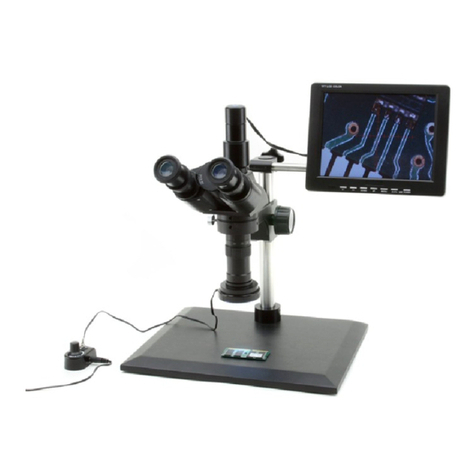
OPTIKA MICROSCOPES
OPTIKA MICROSCOPES XZ-2 User manual
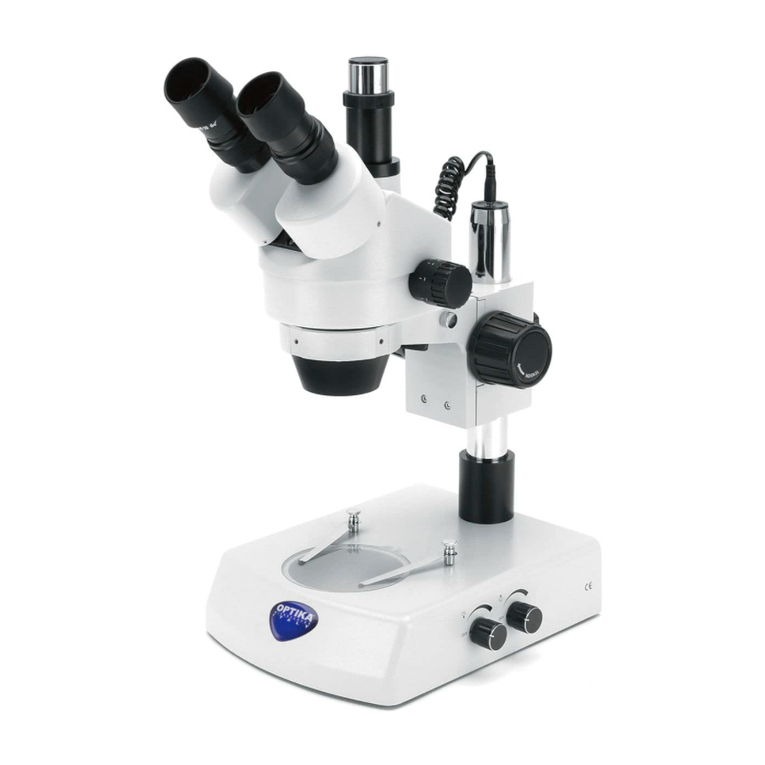
OPTIKA MICROSCOPES
OPTIKA MICROSCOPES SZM Series User manual
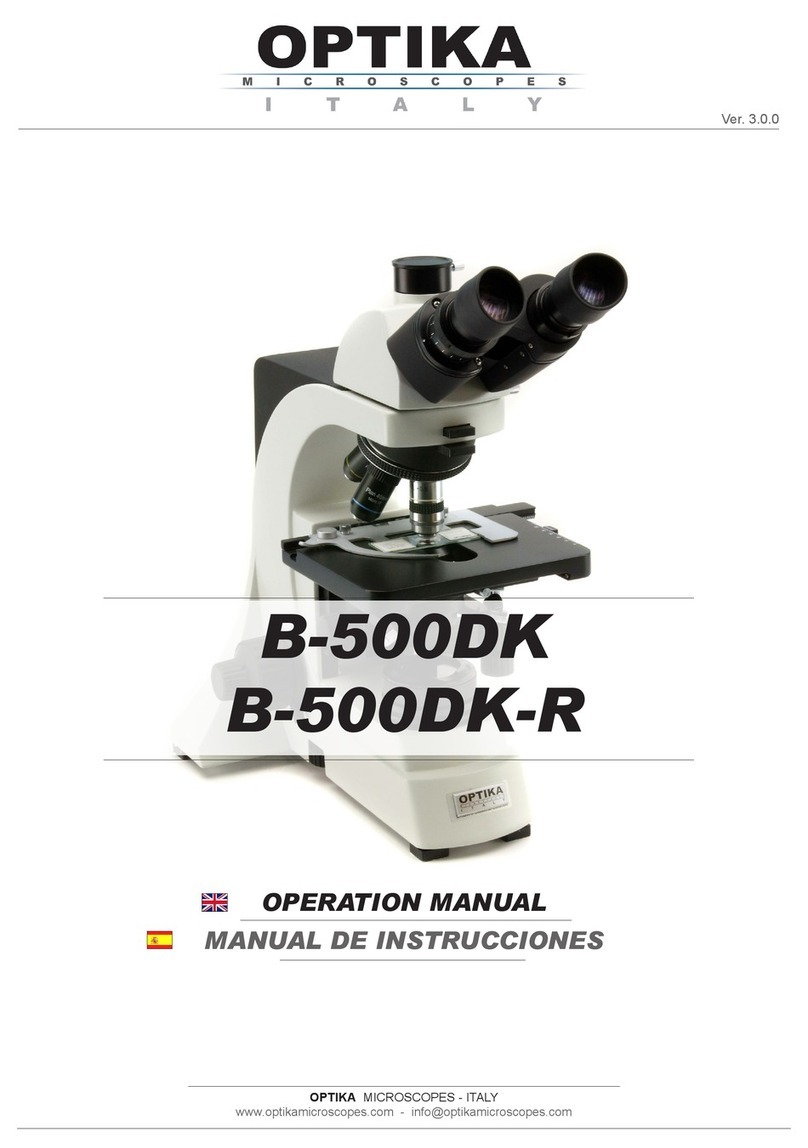
OPTIKA MICROSCOPES
OPTIKA MICROSCOPES B-500DK User manual
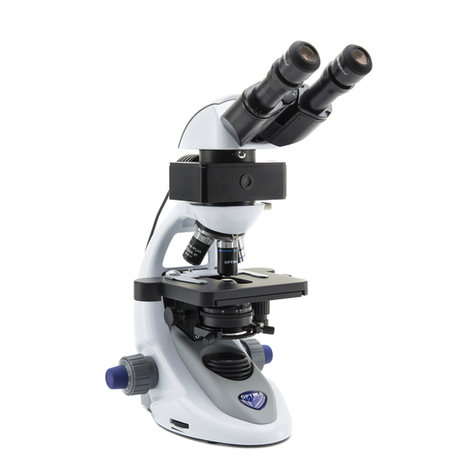
OPTIKA MICROSCOPES
OPTIKA MICROSCOPES B-290 Series User manual
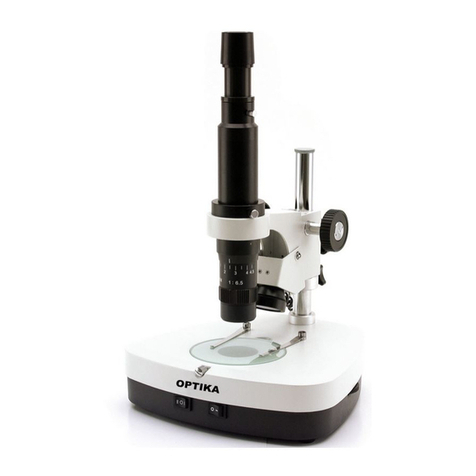
OPTIKA MICROSCOPES
OPTIKA MICROSCOPES XZ-1 User manual
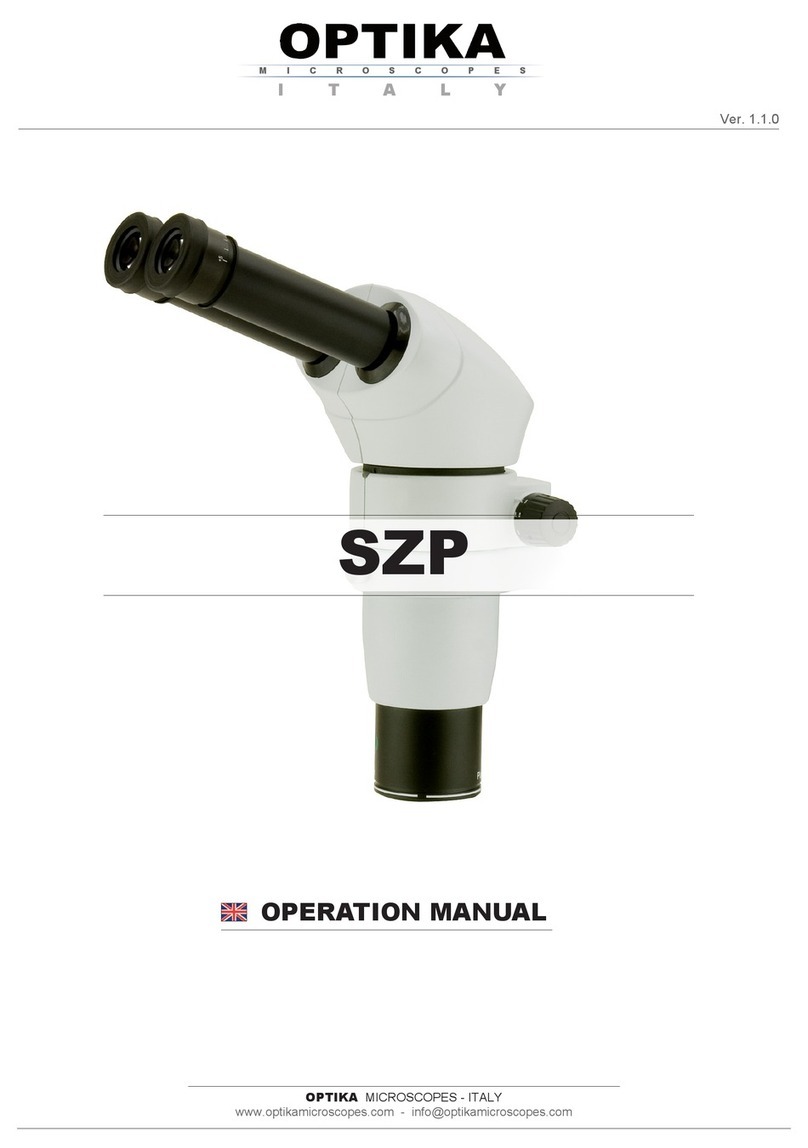
OPTIKA MICROSCOPES
OPTIKA MICROSCOPES SZP User manual

OPTIKA MICROSCOPES
OPTIKA MICROSCOPES B-150D User manual

OPTIKA MICROSCOPES
OPTIKA MICROSCOPES XDS-3 MET User manual
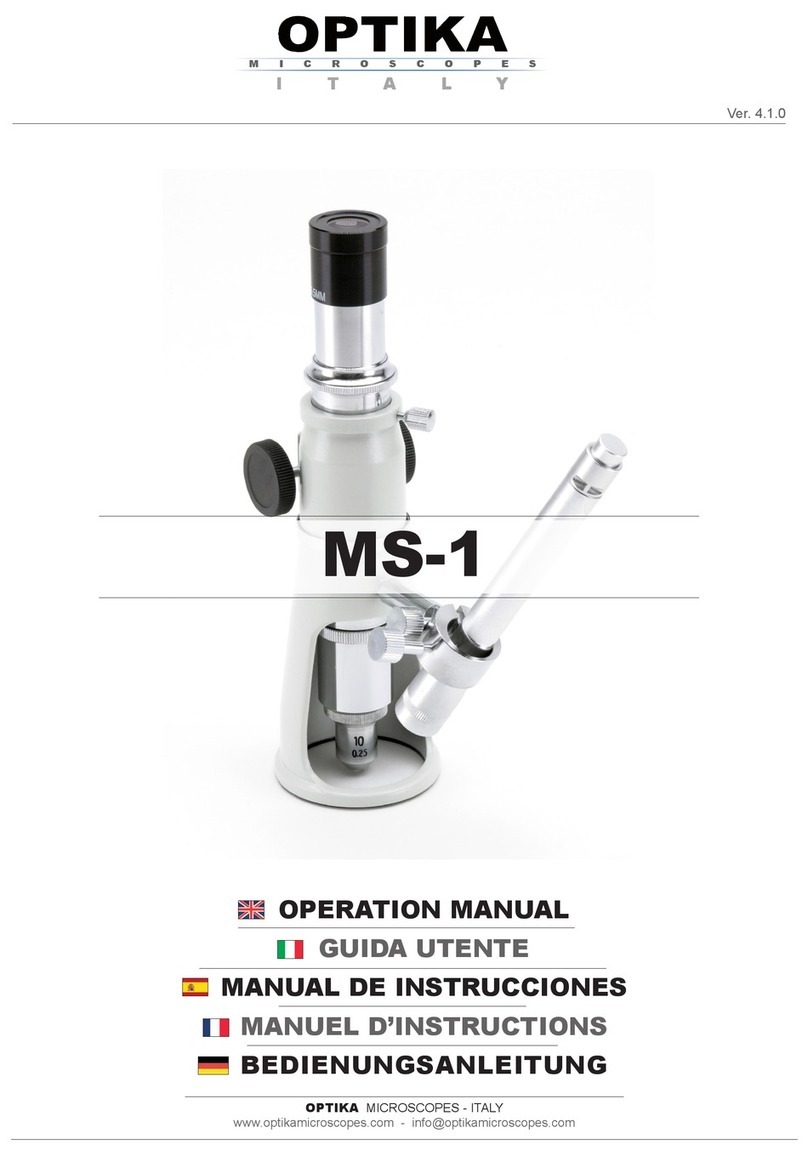
OPTIKA MICROSCOPES
OPTIKA MICROSCOPES MS-1 User manual
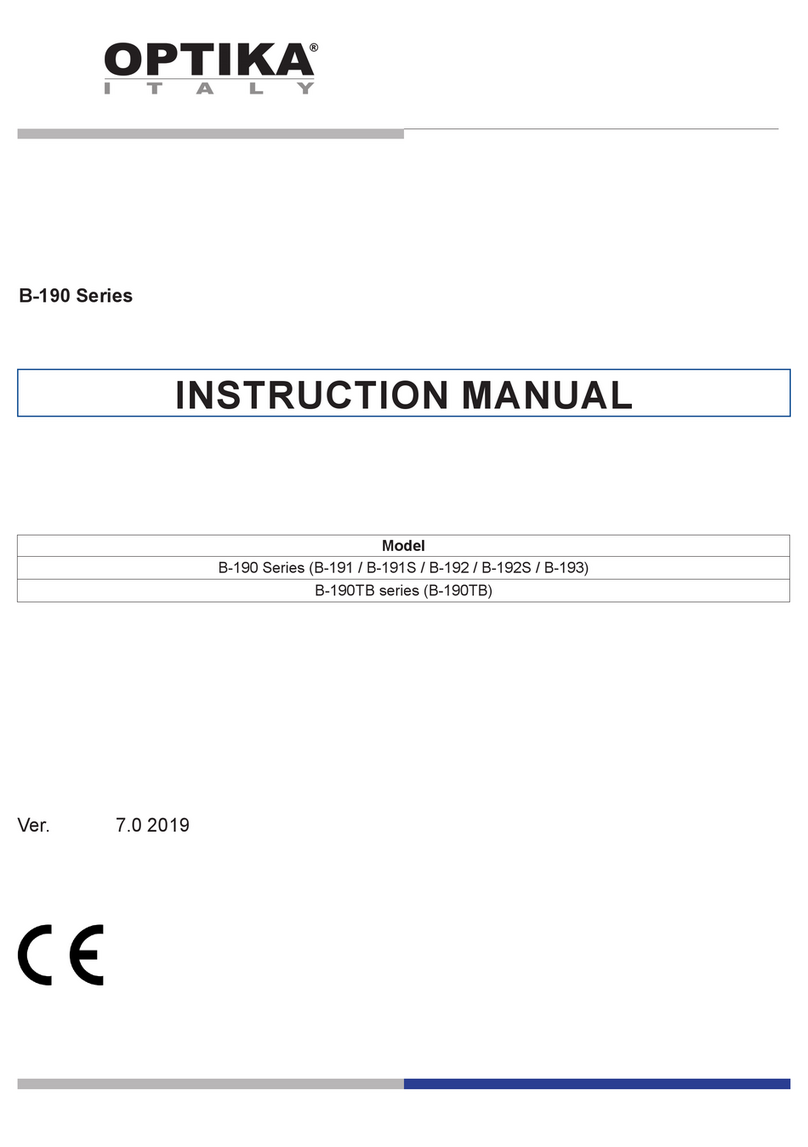
OPTIKA MICROSCOPES
OPTIKA MICROSCOPES B-190 Series User manual
